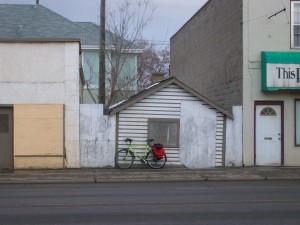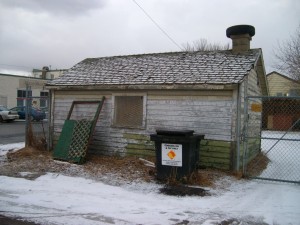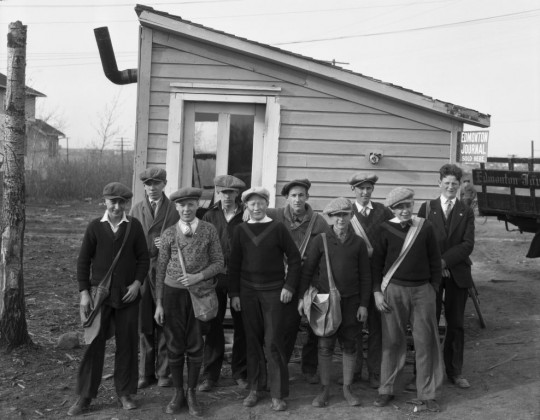LOVE SHACK: Can a shed be a historical building? In this town it can!
Posted on February 29, 2012 By Rob Drinkwater Culture, Front Slider
For generations of Edmonton boys, 12 was a magic age – because you were now old enough to get a paper route. You could earn your own money. You had responsibility and status. And you were granted entry to the legendary “Paper Shacks.”
Edmonton once had dozens of paperboy shacks where boys gathered daily to collect their stacks of Edmonton Journals for evening delivery, but now only a handful of the distinctive, squat sheds remain – and there are no plans to preserve any of them.
 “Unfortunately in Edmonton they tear everything down,” said John Tiemessen, who owns a property at 10265 95 Street where one of the city’s last remaining shacks sits forgotten between two shuttered businesses (right). He’d hoped Fort Edmonton Park might preserve the shack, but the park has concluded it isn’t old enough. “I think it’s an absolute shame,” he said.
“Unfortunately in Edmonton they tear everything down,” said John Tiemessen, who owns a property at 10265 95 Street where one of the city’s last remaining shacks sits forgotten between two shuttered businesses (right). He’d hoped Fort Edmonton Park might preserve the shack, but the park has concluded it isn’t old enough. “I think it’s an absolute shame,” he said.
The shacks were officially called “district offices” and were an essential part of The Journal’s home delivery system starting in 1913 with seven paperboys. The boys would go to the shacks right after school and wait for the delivery truck to arrive with that day’s edition. An older boy would be appointed shack manager and had the key to open and close the shack. The boys counted out their papers on benches inside, put them into bags which they slung over their shoulders, and then headed out the doors to their routes.
Inevitably, there were days when the trucks were late. So the boys played pranks, fought, and told dirty jokes to pass the time. The sheds all had a chimney with an oil drum stove inside, and the boys burned old newspapers to keep warm while sitting on the benches.
“A lot of kids, if they had to wait around, would try to heat up their shoes or boots on the stove and they would melt the soles. Or they’d throw wet paper in the stove and fill the shack with smoke,” recalled Harry de Pruis, who began as a paperboy in the 1959 and later became a shack manager. “The papers came in bundles that were held together with straps. Sometimes kids would be strapped to the centre bench just for the fun of it. The shack manager would try to keep them under control, almost like a teacher, but he was really not much older than the paperboys were.”
The shacks De Pruis worked from are long gone, but he remembers the one on Tiemessen’s property. So does architect Gene Dub, who delivered The Journal in the 1950s to the Alberta Hotel – a building he would later end up owning (and since sold to CKUA).
In 2008, Tiemessen contacted Fort Edmonton Park to see if anyone was interested in preserving the building. He wants to develop the land and would prefer to donate the shack rather than tear it down. Janne Switzer, a researcher from Fort Edmonton Park, actually prepared a report on the shack. It says a Journal librarian found an account from a former paperboy that described a shack in 1914 that had been just north of the Gibson Block on Jasper Avenue. As the shacks were often moved, there was speculation the shack sitting on 95th Street may have once been the shack the paperboy described.
Switzer’s report states that when her investigation began, there was even discussion that some Edmonton Journal employees might supply funding to move the 95th Street shack to Fort Edmonton Park. She said someone also called the Fort Edmonton Foundation saying that his father had been a shack manager and that he would be interested in placing a memorial plaque inside the preserved shack.
“Aside from how he knew we were looking at this, the example illustrates the sensitive, if not enthusiastic, nature of this examination,” Switzer says in the report.
Unfortunately, Switzer concluded the shack was likely built no earlier than the 1950s. Maps and city plans from previous decades don’t show any building at the site at all. The cut-off for preservation within Fort Edmonton Park is 1929. Switzer also noted the shack’s floor had sunk about eight inches and was rotting, which meant the structure would be expensive to move.
 De Pruis, who went on from being a paperboy to spending his entire career at The Journal, has made a list from memory of all the former locations of Edmonton paper shacks. He said there’s another surviving shack behind Tasty Tom’s Restaurant on Whyte Avenue that looks similar to the 95th Street shack. The restaurant uses it as a storage shed. There’s another more modern one from the 1960s of 1970s on the north side of 107 Avenue at 163 Street.
De Pruis, who went on from being a paperboy to spending his entire career at The Journal, has made a list from memory of all the former locations of Edmonton paper shacks. He said there’s another surviving shack behind Tasty Tom’s Restaurant on Whyte Avenue that looks similar to the 95th Street shack. The restaurant uses it as a storage shed. There’s another more modern one from the 1960s of 1970s on the north side of 107 Avenue at 163 Street.
He said he moved a number of shacks over the years – apparently they could be hoisted onto a flatbed and moved to a new site in half a day – and he believes the 95th Street shack is older than the 1950s. But he’s not sure how much older.
David Holdsworth, heritage planner with the city, admitted he was unaware of the existence of the shacks, or what they were used for, when contacted recently by Gig City. But he was instantly intrigued. “I love the idea of trying to save one, but the obvious problem is where to put it,” Holdsworth pondered. He said if the city preserved one, it would ideally be placed in a location where a shack originally stood, but most of those sites are now on private property.
Paperboys have fond memories of their days delivering the news, which would explain the enthusiasm about the possible preservation of an original paper shack.
In 2004, when the Edmonton Journal was celebrating its 100th anniversary, the paper held a banquet for former paperboys called “Back to the Shack.” The idea came from Allan Wachowich, who was at the time Chief Justice of the Court of Queen’s Bench, and had been a Journal paperboy in the 1940s.
“The experience of being a paperboy was a profound, profound experience for me,” said Wachowich. He’d urged then-Journal publisher Linda Hughes to hold an event for paperboys, and he wanted to hold it at the Hotel Macdonald because he said that’s where the Journal used to hold annual banquets for its carriers. He even wanted Baked Alaska for dessert, just like they’d had as boys. Hughes told him she’d put an ad in the paper to see if anyone was interested in coming, and she promised to hold the party if they got 90 responses. They ended up getting 200. The Empire Ballroom was filled, and they even had a re-creation of a shack on the stage.
Towards the end of the 1970s, The Journal began dropping individual bundles on corners for paperboys on some routes instead of distributing them at shacks. When they no longer needed any shacks at all in the 1980s, going to adult carriers with vehicles, the buildings were forgotten or sold. Glen McLean, who operated This Planet Natural Foods in the 1990s next door to the 95th Street shack, said he approached The Journal in 1995 and bought the building for $25. He said he filled out some forms at The Journal offices and gave them the money, but got a phone call from an embarrassed Journal employee the next month saying they’d already sold the shack to his neighbour who owned a corner grocery. The shack became Tiemessen’s when he took over the property.
McLean was never a paperboy himself but remembers hanging around a shack because his friend was one. McLean recalled that at the shacks, everybody wanted to get their papers first so they could get their routes done quickly. That meant there was always competition, and a pecking order, for who got their bundles first.
“It was sort of like a rink shack where the younger boys were, like, in awe of the older boys, but didn’t want to show it,” McLean recalls. “The older boys would be acting cool and confident. Sometimes they’d be assholes and a younger boy would have to be careful about saying anything or he might end up in a fight.”
Occasionally, passers-by would get caught in the hijinks. According to a tale that’s told by Harley Reid in a series of stories on the Edmonton Public Library website called “A City Called Home,” vehicles passing paper shacks on winter afternoons were prime targets for snowballs. Reid described waiting at a paper shack on 101 Street between 106 and 107 Avenues on a Saturday afternoon right before Christmas in 1943. The boys noticed a U.S. Army truck with soldiers sitting in the back lumbering up 101 Street, and as it passed, the paperboys pelted the truck and the soldiers with snowballs while shouting, “Merry Christmas!”
The driver hit the brakes and the boys scattered. They returned to the shack later when the coast was clear, but Reid said they were so busy boasting about their marksmanship that they didn’t notice the truck returning from another direction until it stopped right in front of them.
“As we gawked in wonder, the canvas cover was flipped back and a raucous din froze us in our tracks. Well aimed and solidly packed snowballs filled the air, contacting with our surprised bodies,” Reid recalled, adding the soldiers shouted “Merry Christmas” back at them. “Those young men, some not much older than us, had beat us at our own game.”
If anyone wants to save a shack, they’ll have to hurry. De Pruis said there was one on 65 Street near the Transit Hotel a few years back, but he said he drove past it one day and noticed a large hole had been cut in the side, possibly because the door wouldn’t open any more. The next time he passed it, it was gone.












